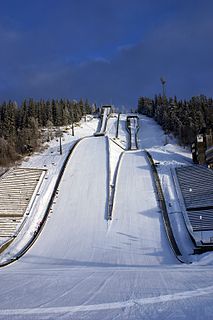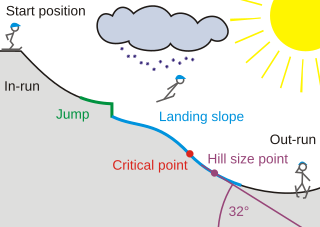
Ski jumping is a winter sport in which competitors aim to achieve the longest jump after descending from a specially designed ramp on their skis. Along with jump length, competitor's style and other factors affect the final score. Ski jumping was first contested in Norway in the late 19th century, and later spread through Europe and North America in the early 20th century. Along with cross-country skiing, it constitutes the traditional group of Nordic skiing disciplines.

Holmenkollbakken is a large ski jumping hill located at Holmenkollen in Oslo, Norway. It has a hill size of HS134, a construction point of K-120, and a capacity for 70,000 spectators. Holmenkollen has hosted the Holmenkollen Ski Festival since 1892, which since 1980 have been part of the FIS Ski Jumping World Cup and 1983 the FIS Nordic Combined World Cup. It has also hosted the 1952 Winter Olympics and the FIS Nordic World Ski Championships in 1930, 1966, 1982 and 2011.

Bjørn Tore Wirkola is a Norwegian former ski jumper.

Ski flying is a winter sport discipline derived from ski jumping, in which much greater distances can be achieved. It is a form of competitive individual Nordic skiing where athletes descend at high speed along a specially designed takeoff ramp using skis only; jump from the end of it with as much power as they can generate; then glide – or 'fly' – as far as possible down a steeply sloped hill; and ultimately land within a target zone in a stable manner. Points are awarded for distance and stylistic merit by five judges. Events are governed by the International Ski Federation.

Andreas "Andi" Goldberger is an Austrian former ski jumper. He became the first man in history to jump over 200 metres in 1994, although he didn't manage to stand.

Lysgårdsbakken, officially known as Lysgårdsbakkene Ski Jumping Arena, is a ski jumping hill in Lillehammer, Norway. It consists of a large hill, with a K-point of 123 and a hill size of 138, and a small hill with a K-point of 90 and a hill size of 100. It opened in 1993 for the 1994 Winter Olympics, where it hosted the ski jumping and Nordic combined events, as well as the opening and closing ceremonies. After the Olympics, ownership was transferred to the municipal Lillehammer Olympiapark and it has since been used for several FIS Ski Jumping World Cup and FIS Nordic Combined World Cup tournaments, including hosting the Nordic Tournament. It has a capacity for 35,000 spectators and is one of three national ski jumping hills in Norway. In 2007, the large hill was rebuilt to a larger profile, and received a new plastic lining. The venue sees 80,000 annual jumps in the winter and 20,000 in the summer season.
The men's ski jumping at the 1928 Winter Olympics took place at the 70-meter (230 ft) Olympiaschanze in St. Moritz, Switzerland, on 18 February. Thirty-eight competitors from thirteen nations competed, with the event being won by Norway's Alf Andersen ahead of countryman Sigmund Ruud and Czechoslovakia's Rudolf Burkert.
Mikkjel Hemmestveit, was a Norwegian-American Nordic skier who shared the Holmenkollen medal with his brother, Torjus Hemmestveit in 1928.

Anders Olsen Haugen was a Norwegian-American ski jumper who won four national ski jumping championships. He competed in the 1924 Winter Olympics in Chamonix and the 1928 Winter Olympics in St. Moritz. Anders Haugen was the first and, as of 2016, only American to win an Olympic medal for ski jumping.

The FIS Nordic World Ski Championships 2009 took place 18 February – 1 March 2009 in Liberec, Czech Republic. This was the fourth time these championships were hosted either in the Czech Republic or in Czechoslovakia, having done so at Janské Lázně (1925) and Vysoké Tatry.

The FIS Nordic World Ski Championships 2011 took place from 23 February to 6 March 2011 in Oslo, Norway, at the Holmenkollen National Arena. It was the fifth time these championships had been hosted in Holmenkollen, having been done previously in 1930, the 1952 Winter Olympics, 1966, and 1982. On 25 May 2006, the 45th FIS Congress in Vilamoura, Portugal, selected the Holmenkollen area over both Val di Fiemme, Italy, and Zakopane, Poland, with a vote of 12 to 4 to 0. These games coincided with the Holmenkollen Ski Festival as they have previously in 1930, 1952, 1966, and 1982.

Copper Peak is a ski flying hill designed by Lauren Larsen and located in Ironwood, Michigan, United States. It was built in 1969 and inaugurated one year later. The site was listed on the National Register of Historic Places in 1973 and designated a Michigan State Historic Site in 1971. The site is currently used as a summer tourist attraction.

Anders Bardal is a Norwegian former ski jumper.

The Große Olympiaschanze is a ski jumping hill located on the Gudiberg, south of the district of Partenkirchen of Garmisch-Partenkirchen, Bavaria, Germany, and is traditionally the venue of the Four Hills Tournament's New Year's jumping.

A ski jumping hill is a sports venue used for ski jumping. They vary in size from temporary handmade snow structures to permanent competition venues. At the top is an in-run where the jumper runs down to generate sufficient speed, before reaching the jump. The skier is then airborne until landing on the landing slope. The last part of the hill is the out-run, which may be either flat or even uphill, allowing the jumper to stop. The steepest point of the hill is the construction point, which is used to determine the score of a particular length. The size of a hill is measured in the hill size. Hills with a hill size exceeding HS185 are designated ski flying hills; there are five such hills in the world.
The 2009–10 FIS Ski Jumping World Cup was the 31st World Cup season in ski jumping and the 13th official World Cup season in ski flying. It started on 26 November 2009 at the Rukatunturi ski jumping hill in Kuusamo, Finland and finished on 14 March 2010 at Holmenkollen, Norway.

Rødkleiva is a hill located in Nordmarka in Oslo, Norway. It was taken into use as a slalom hill in 1947 and was used for the combined event of the Holmenkollen Ski Festival eleven times between 1947 and 1963. It hosted the slalom events for the 1952 Winter Olympics, which saw a crowd of at least 25,000 spectators. The Olympic course was 422.5 meters (1,386 ft) long and had a drop of 169 meters (554 ft). The course gradually fell into disrepair and was closed in 1988.
Old Bolgenschanze is an abandoned K53 ski jumping hill at Davos, Switzerland from 1909. It was located on the same road as new Bolgenschanze, only abot 500 meters away.
Trampolino al campo Smith was a K40 ski jumping hill located in Bardonecchia, Italy.













